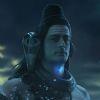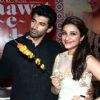|| Shree Ganeshaya Namaha ||
|| Om Namah Shivaya ||

Maha Shivratri is a Hindu festival celebrated every year in reverence of Lord Shiva. It is also known as Padmarajarthi. Shivratri literally means the great night of Lord Shiva. It is celebrated every year on the 13th night/ 14th day of the Maagha or Phalguna month of the Hindu calendar. Since many different calendars are followed by various ethno-linguistic groups of India, the month and Tithi name are not uniform all over India. Celebrated in the dark fortnight or Krishna Paksha (waning moon) of the month of Maghaa according to the Shalivahana or Gujarati Vikrama or Phalguna according to the Vikrama era. The festival is principally celebrated by offering of Bael or Bilva/Vilvam leaves to Lord Shiva, all day-fasting and an all-night vigil. In accordance with scriptural and discipleship traditions, penances are performed in order to gain boons in the practice of Yoga and meditation, in order to reach life's sum mum bonum steadily and swiftly. A week-long International Mandi Shivratri Fair held at Mandi in the Indian state of Himachal Pradesh every year is one of the tourist attractions in the state.

Each attribute of Lord Shiva has it's own importance listed below

Shiva has a trident in the right lower arm, with a crescent moon on his head. He is said to be fair like camphor or like an ice-clad mountain. He has fire and Damaru and Mala or a kind of weapon. He wears five serpents as ornaments. He wears a garland of skulls. He is pressing with his feet the demon Mulayaka, a dwarf holding a cobra. He faces south. Panchakshara itself is his body. It is believed that Shiva became a god through meditating everyday

Shiva bears on his head a crescent moon. The epithet Chandrasekhara (Chandra=moon sekhara=crest, crown) refers to this feature. The crescent moon is shown on the side of the Lord's head as an ornament. The waxing and waning phenomenon of the moon symbolizes the time cycle through which creation evolves from the beginning to the end. Since the Lord is eternal reality, he's beyond time. Thus the crescent moon is only one of His ornaments. The wearing of the crescent moon in his head indicates that He has controlled his mind perfectly.

Shiva smears his body with ashes (bhasma). Some forms of Shiva such as Bhairava are associated with a very old India n tradition of cremation- ground asceticism that was practiced by some groups who were outside the fold of Brahmanic orthodoxy. One epithet for Shiva is "inhabitant of the cremation ground" (Sanskrit: - smasanavasin, also spelled as Smashanavasin), referring to this connection.

Shiva's distinctive hairstyle, the one with matted hair' and Kapardin endowed with matted hair' or wearing his hair wound in a braid in a shell- like (kaparda) fashion. A kaparda is a cowrie shell, or a braid in the form of a shell, or more generally, hair that is shaggy or curly. His hair is said to be like molten gold in colour or being yellowish- white.

The epithet Nilkantha refers to a story where Shiva drank the poison churned up from the world ocean.

The ganga rive flows from the matted hair of Shiva. The epithet Gangadhara (bearer of Ganga) refers to this. The Ganga, one of the major rivers of India, is said to have made abode in Shiva's hair. The flow of Ganga also represents the nectar of immortality

He is often shown seated upon a tiger skin, an honour reserved for the most accomplished of Hindu ascetics, the Brahmarishis. Tiger represents lust. His sitting on the tiger skin indicates that He has conquered lust.

Shiva is often shown garlanded with a snake. His wearing of serpents on the neck denotes wisdom and eternity.

His holding deer in one hand indicates that he has removed the Chanchalata (tossing) of the mind. Deer jumps from one place to another swiftly. The mind also jumps from one object to another.

Shiva's particular weapon is trident. His trishul that is held in His right hand represents the three Gunas- Sattva, Rajas and Tamas. That is the emblem of sovereignity. He rules the world through these three Gunas. The Damaru in his left hand represents the Sabda Brahman. It represents the OM from which all the languages are formed. It is He who formed the Sanskrit language out of the Damaru sound.

A small drum shaped like an hourglass is known as damaru. This is one of the attributes of Shiva in his famous dance- representation known as Nataraja. A specific hand gesture (mudra) called damru-hasta is used to hold the drum. This drum is particularly used as an emblem by members of Kapalika sect.

Nandi also known as Nandin, is the name of the bull that serves as Shiva's mount. Shiva's association with cattle is reflected in his name, Pasupati or Pashupati, translated by Sharma as lord of cattle' and by Kramsrich as lord of animals' who notes that is particularly used as an epithet of Rudra. Rishabha or the bull represents the Dharma devta. Lord Shiva rides on the bull. Bull is his vehicle. This denotes that Lord Shiva is the protector of Dharma, an embodiment of Dharma or righteousness.

The Ganas are attendants of Shiva and live in Kailash. They are often referred to as bhutaganas, or ghostly hosts, on account of their nature. Generally benign, except when their lord transgressed against, they are often invoked to intercede with the lord on behalf of devotee. Ganesha was chosen as their leader by Shiva; hence Ganesha's title Ganapati which means lord of Ganas.'

Mount Kailash in the Himalayas is his traditional abode. In Hindu mythology, mount Kailash is conceived as resembling a linga, representing the centre of the universe.

Varanasi or Benaras is considered as city specially loved by Shiva, and is one of the holiest places of pilgrimage in India. It is referred to in religious contexts as Kashi.
*******

Apart from anthropomorphic images of Shiva, the worship of Shiva in the form of lingam, or linga, is also important. These are depicted in various forms. One common form is the shape of a vertical round column. Shiva means auspiciousness, and lingam means a sign or a symbol. Hence the Shivlinga is regarded as a symbol of the great God of universe who is all-auspiciousnes.' Shiva also means one in whom the whole creation sleeps after dissolution.' Linga also means the same thing- a place where created objects get dissolved during the disintegration of the created universe. Since, it is the Shiva who creates, sustains and withdraws the universe, the Shivalinga represents symbolically the God himself.
*******

The bilva tree corresponds to the spinal column. The tree's leaves are special: each stalk has three leaflets. The three leaflets represent the three nadis mentioned above. The climbing of the tree represents the ascent of the kundalini shakti from the muladhara to the ajna chakra.
Keeping awake is symbolic of the kind of awareness and oneness of purpose that a spiritual aspirant needs to reach the goal. He cannot afford to be slack even for a moment.
Shiva is the Supreme Consciousness that illuminates the three states of waking, dreaming and deep sleep. Offering the threefold bilva leaves to the Shivalinga heralds the return to a level of consciousness beyond the three states, which is the fourth state, turiya. The dawning of that state is consonant with the awakening of the individual.
******

From the very early morning, Shiva temples are flocked by devotees, young and old, who come to perform the traditional Shivlinga worship (puja) and hence hope for favours from the god. Devotees bathe at sunrise, preferably in Ganges, or any other water source (like the Shiva Sagartank at Khajuraho). This is a purificatory rite, an important part of all Hindu festivals. Wearing a clean piece of clothing after the holy bath, worshippers carry pots of water to the temple to bathe the Shivalinga. They offer prayers to the sun, Vishnu and Shiva. Women pray for the well being of their husbands and sons. An unmarried woman prays for a husband like Shiva, who is considered to be ideal husband. The temple reverberates with the sound of bells and shouts "Shankerji Ki Jai" or "Har Har Mahadev" meaning Hail Shiva.' Devotees circumambulate the linga, three or seven times, and then pour water over it. Some also pour milk.
According to Shiva Purana, the Maha Shivratri Pooja must incorporate the 6 items:-
1. Bathing the Shiva linga with water, milk and honey, and Wood apple or bel leaves added to it, represents purification of soul;
2. The vermillion paste applied on the Shiva linga after bathing it represents virtue.
3. Offering of fruits, which is conducive to longevity and gratification of desires
4. Burning incense, yielding wealth
5. The lightning of the lamp which is conducive to the attainment of knowledge.
6. And betel leaves marking satisfaction with worldly pleasures
Tripundra refers to the 3 horizontal stripes of holy ash applied to the forehead by worshippers of Lord Shiva. These 3 stripes symbolize spiritual knowledge, purity and penance (spiritual practice of Yoga), so they represent the 3 eyes of Shiva.
Wearing a rosary made from the rudrakash seed of the rudrakash tree (said to have sprung from the tears of Lord Shiva) when worshipping Lord Shiva is ideal. A rudrakash seed is a mahogany-like colour, sometimes black, and sometimes may have traces of sacred sandalwood powder, turmeric, kumkum, or holy ash if the rosary was used in worship ceremonies or anointed.


















































comment:
p_commentcount